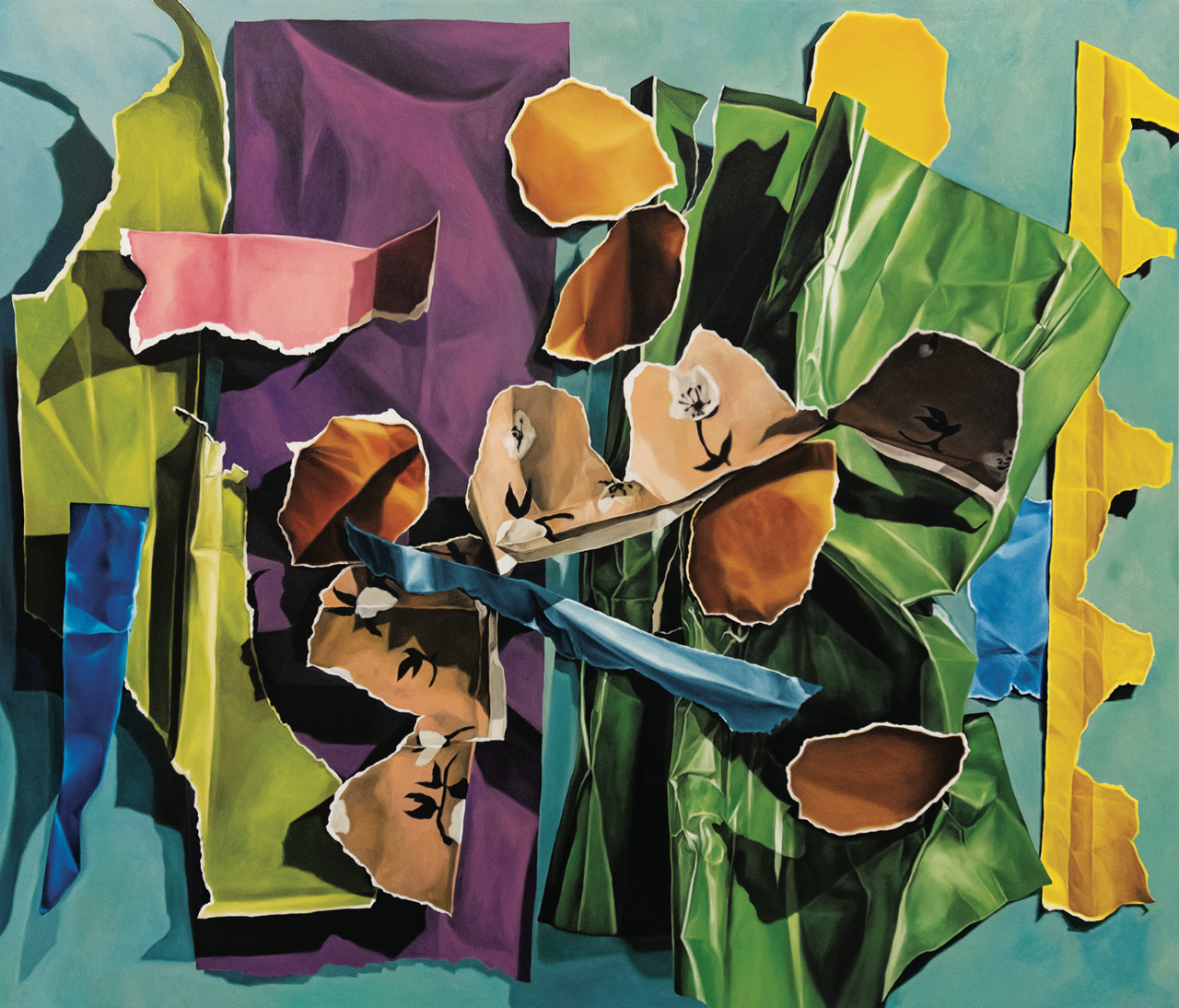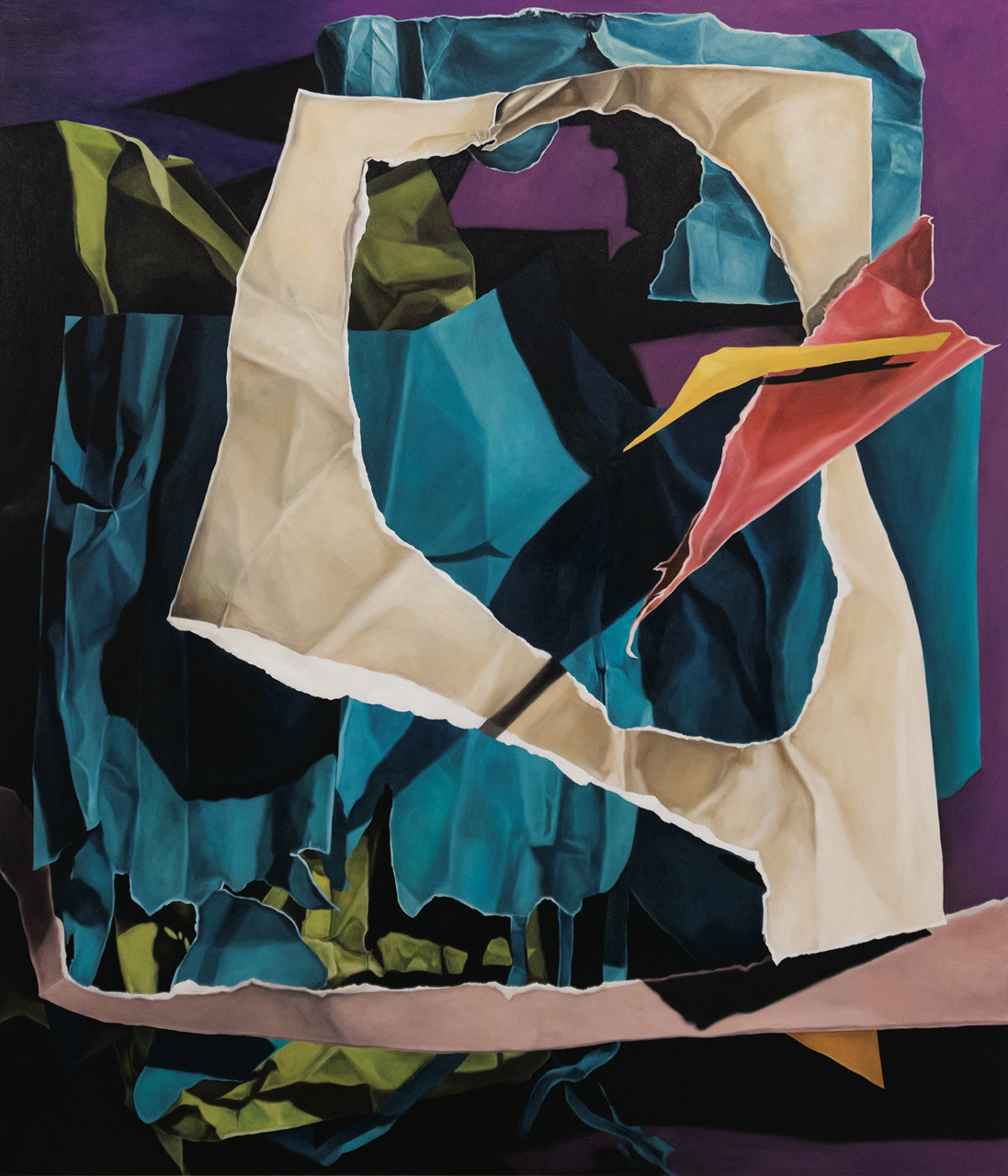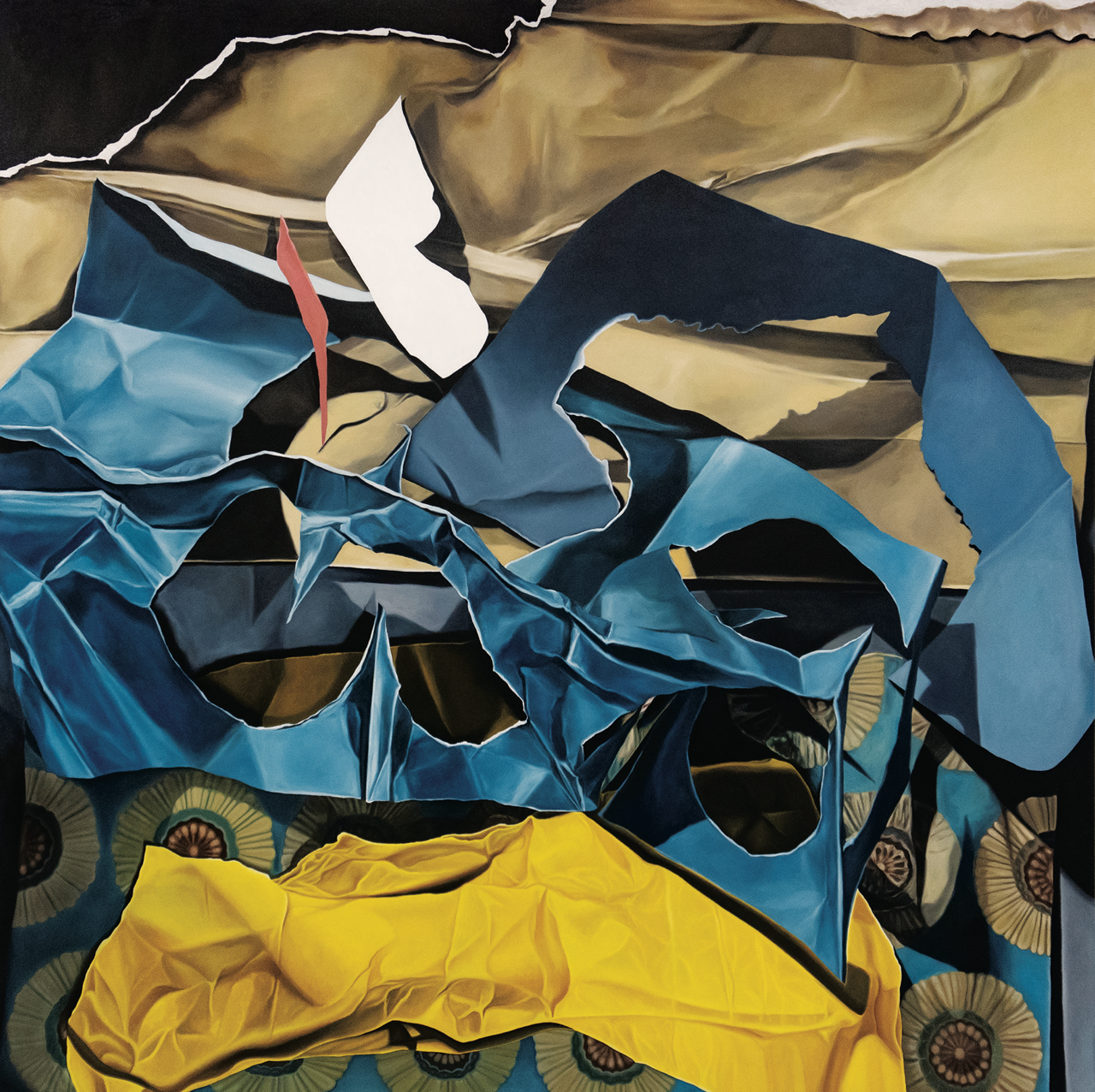Filling The Blank Slate
Ayka Go paints paper in all its many forms and potentialities.
Written by Mara Fabella
March 15, 2023
Ayka Go in front of her work
A blank sheet of paper is a blank slate. For artist Ayka Go, this is true in more ways than one. Go is known for her adept skills as a painter, describing textures with such realism, they jump out of her canvases. Her subject matter makes her works even more distinct: paper. From torn and crumpled scraps to unseen forms completely enveloped, Go explores the full spectrum of possibilities presented by a surface as unpredictable yet physical as paper. Her strikingly rendered works reflect an artist with an intimate understanding of her subject—what it is and what it can be. More than depicting paper as it appears, her works seem to ask viewers what they see. What fills the blank slate?
Go’s relationship with paper draws back to her childhood. As a child, she recalls being left with paper to make something. She recalls her father making paper boats and airplanes while playing. Paper was a means to pass time and to create. She preserved these moments in her diaries, deepening her connection to paper not simply as a means to do, but as a marker of memory.
“Paper is so close to me,” Go reflects. This early connection with paper bore fruit in her thesis work at the University of the Philippines Diliman, where she majored in Painting. For her thesis, she recreated these pages from her childhood diaries and formed them into a dollhouse sculpture, effectively revealing and concealing facets of her memory, just as paper is wont to do. After graduating, Go found she couldn’t let go of paper and the vast potential carried by the medium.
In the span of a few years, Go has already built a prolific career as a full-time artist. Her paintings, ranging from large-scale splashes of color to smaller monochromatic affairs, have graced the walls of Finale Art File, West Gallery, Underground Gallery, and Kaida Contemporary, to name a few. Her works have also been exhibited in shows by Tang Contemporary in Bangkok. Go has partnered with Singapore-based Yavuz Gallery, and in 2022, they hosted her massive and vivid collage paintings in her solo show, Of Shadows and Collected Time. Her pieces have also been exhibited in France, Australia, Italy, Taiwan, Hong Kong, China and Thailand.
Installation view of Ayka Go's exhibition, Of Shadows and Collected Time (2022)
“When I touch paper, there’s a different kind of high,” Go says. Her familiarity with her subject comes through her works as paper becomes a playing ground for realism and expressiveness to intersect. Early on as a painter, Go claims she would prioritize expression in her strokes. But the challenge of realism proved too enticing, as she now attempts to capture each surface as closely as she can. With a material as versatile yet fragile as paper, Go says she learned how to observe the nuances of her subject more intimately. While she still closely works off references, she also leans on intuition, occasionally deviating from subjects as guided by her own sensibilities. The balance is a delicate one, but Go treads it skillfully as she finds the expression within the realism, effectively encouraging her viewers to find the emotion and silent beauty within her paper subjects.
Stumbling on to collage painting was a bit of serendipity for the artist. While cleaning up fragments of paper at her studio after production for Art Fair Philippines, she found herself transfixed by the mounds they spontaneously formed. Go recalls her first Collage Study painting fondly as her ensuing collage-based works grew even more intricate, distilling the spontaneous energy of a collage through such a precise material. In her solo show Play, Cut, Stick, Paint (2021) at West Gallery, Go created a series of both actual collages and collage paintings based on randomly collated words. The nature of these works allowed her to disengage with the more rigid tenets of representation and immerse in the play aspect of collage.
Go’s often dynamic compositions, together with her specific subject matter, allow her to traverse the boundaries between abstraction and realism. The subtle illusion in her works lies in her ability to evoke paper so accurately yet remain ambiguous altogether. Are these scraps of paper, or are they abstract masses of color tearing through the seams of the visual plane? Though the duality is palpable, Go says she never purposely leans toward one or the other. Art remains her therapeutic outlet, and whatever visuals arise are communicated from the internal rather than the intentional. Yet Go’s art speaks to the nature of the intuitive space creative expression can lead one towards, where the familiar and unfamiliar co-exist harmoniously.
A common motif in Go’s works is the wrapped form. Her solo exhibit Some Things We Call Home (2021) at Finale Art File depicted her signature paper backdrops against enveloped objects resembling toys. Through these works, Go invokes the idea of the form through a kind of smokescreen. She elicits the feelings and recollections one may have with such objects without ever directly implying their presence. In a piece for the recently concluded Art SG (2023), she used shades of pink and gold to enshroud the apparent form of a gun. Tapping into affiliations with gender and politics, specifically around the color pink, Go once again presents her viewers with a blank slate upon which to project their own thoughts and memories. The paper forms become what one makes of them.
(From left: Collage Study 11.5, 2022, 182.5 x 213 cm, oil on canvas; Collage Study 10.7, 2022, 213 x 182.5 cm, oil on canvas; Collage Study 13.5, 2022, 208.5 x 208.5 cm, oil on canvas)
While Go mostly identifies as a painter, she also calls herself a maker. Sculpture remains part of her practice as an extension of her exploration through painting. Go is fascinated by the nature of paper to shift so seamlessly from 2D to 3D at the slightest crease. She delved into the crumpled paper in her show Shape and Form (2022) at West Gallery through paintings, graphite drawings, and epoxy sculptures. Abandoning the spectacle of her colored pieces, she goes monochromatic, highlighting the complexity of a form so deceptively simple—a concrete manifestation of touch and experience.
Reflecting upon the trajectory of her body of works, Go recalls times where ideas and goals failed to materialize due to different circumstances. In a way, the process has become diaristic and the works become expressions of different moments in her life only known to the artist. Similarly, one may look upon her works and ponder on their own personal relationship with paper. What kind of meaning does one find in paper, in all its ubiquitous and unassuming nature?
For Go, this special and enigmatic relationship can be found in the ordinary. “You see it every day. You’re familiar with paper.” Whether an artist or not, paper is one of the most basic materials one is introduced to. From childhood, one is taught to use paper as an outlet for all kinds of expression. It represents a tangible symbol for memory, creation, exploration, and more.
The draw of the ordinary lies in its capacity to infuse all this power into the day-to-day. In the art of Ayka Go, one is reminded of infinite possibilities.





